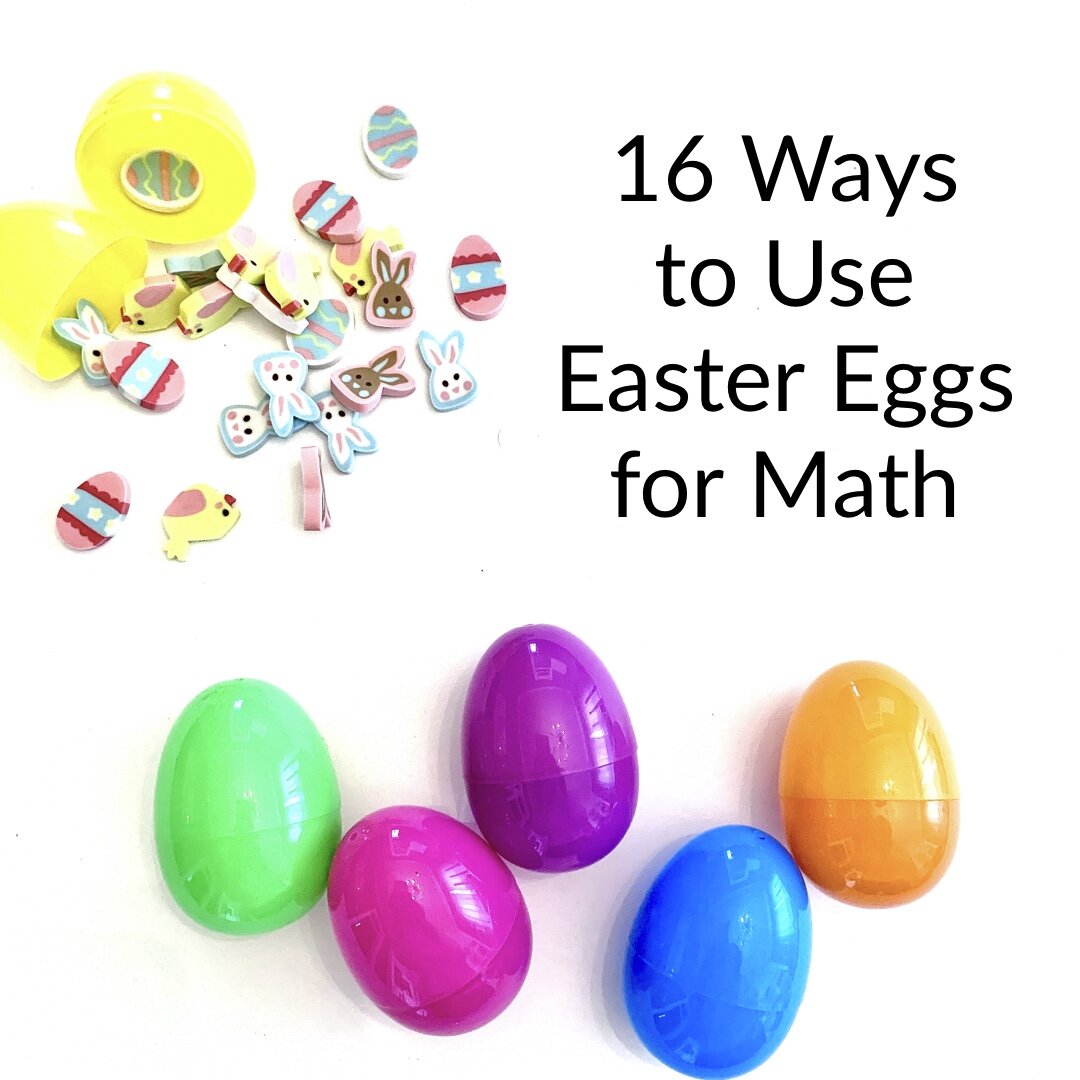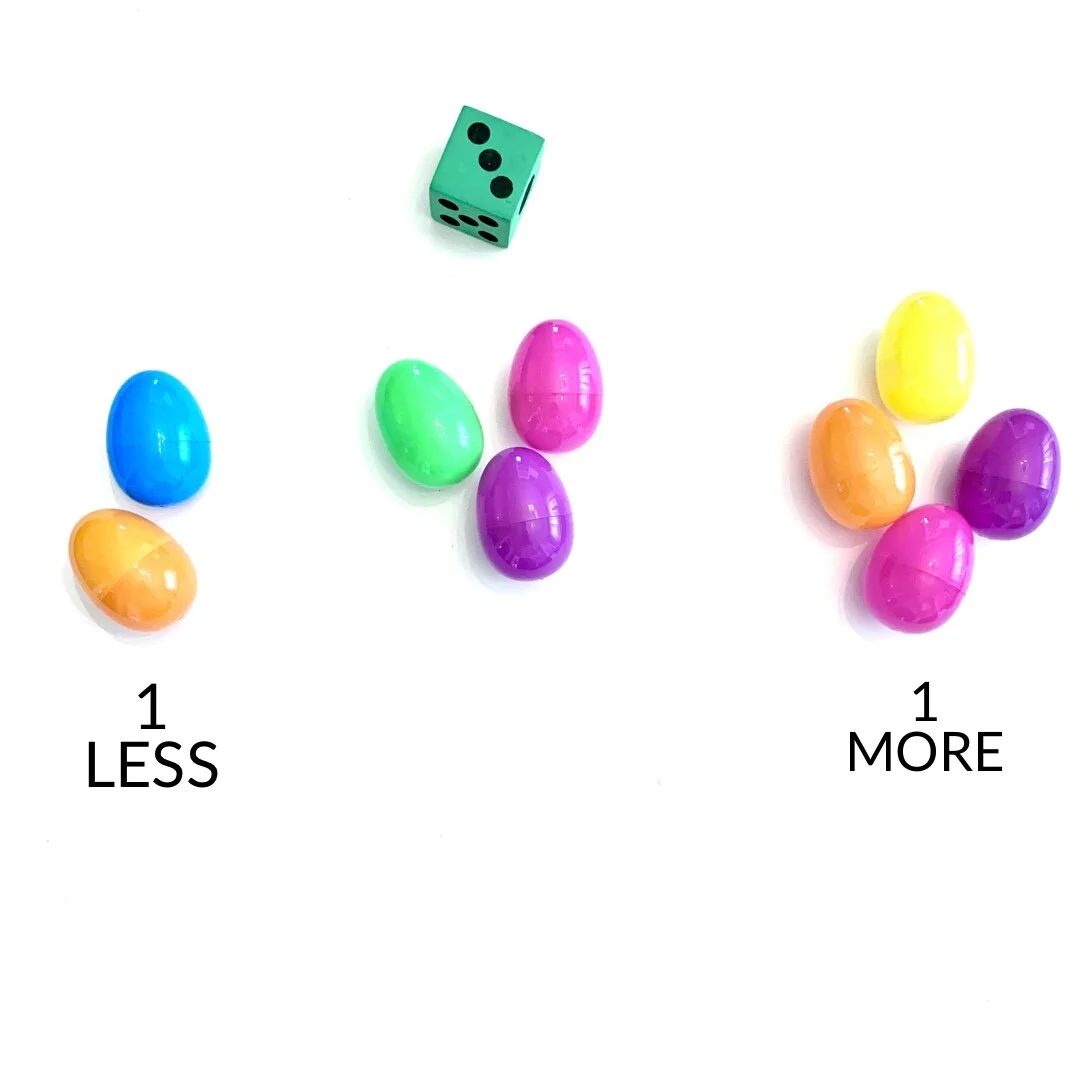16 Ways to Use Easter Eggs for Math
It’s Easter egg time! If Easter is a holiday your family celebrates and you’ve got some plastic Easter eggs lying around, then take a look at this list of ways to incorporate math into play with Easter eggs.
Domino Egg Hunt: Place individual dominoes inside Easter eggs. Place a set of post-its numbered 0 through 12 in a row on a table. Hide the eggs and let your children hunt for them. As they open the eggs, children count the total number of dots on the domino and place it with the corresponding number on the post-it. (Ex: A domino with 2 dots on the left side and 3 dots on the right side would be counted as 5 dots total and placed below the post-it with a 5.) A kindergarten or older child can also write out the corresponding addition sentence for each domino (2 dots and 3 dots on a domino would be 2 + 3 = 5).
Easter Egg Patterns: Create patterns of two or three repeating Easter egg colors. (Ex: Blue egg, yellow egg, blue egg, yellow egg…. or pink egg, blue egg, yellow egg, pink egg, blue egg, yellow egg…) Let your child complete what comes next in the pattern.
Debug Easter Egg Patterns: If your child is ready for a little more of a challenge with their Easter egg patterns, create a color pattern like the above examples and then place an error inside the pattern. Tell your child there’s a mistake in the pattern. Let them find it and fix it.
Practice Ordinal Numbers: Ordinal numbers are the numbers that tell us the order objects are in: first, second, third, fourth, and so on. Practice using those numbers by telling your child you’re going to make a line of eggs. Give them directions for which eggs to put in the line using ordinal numbers. (Ex: First in the line will be a blue egg. The second egg should be pink. Third we need a green egg. Our last egg will be yellow.) Then switch and let your child give you directions for a line of eggs using ordinal numbers. If they say “one” instead of “first,” for example, simply explain the difference and ask them to try the direction again using the word “first.”
Count the Collection: Counting collections of high-interest objects is a wonderful way to encourage your child to practice counting increasingly larger quantities of objects. Simply place a large group of eggs in front of your child (the quantity of eggs should be a few larger than what you know they can count independently) and prompt them with something like, “Wow! We have so many Easter eggs. I wonder how many we have! Can you help me figure out how many eggs we have?”
Sort by Color: After your child has counted all the eggs (see above), they can practice sorting the eggs into smaller groups based on color. This is a fantastic way to practice classifying objects that feels both fun and relevant for your child.
Compare Color Collections: If your child has created groups of eggs based on color (see above), you now have a perfect opportunity to talk about which group has the most and which group has the least. When first starting to compare quantities, a child will identify the group with the most by recognizing that the number comes later in the counting sequence than the other. (Ex: There are 4 green eggs and 2 blue eggs so I know there are more green eggs than blue eggs because 4 comes after 2.) After a child can easily identify which group has more, begin talking about how many more.
Practice Early Color Matching (especially great for a young toddler): Easter eggs are a great tool for color matching with your young toddler. Take out an egg and ask them to find one of the same color. (Ex: This is a blue egg. Can you give me another blue egg?)
Create Groups of 1 More and 1 Less: Roll a dice and let your child build a set of eggs that is equal to the number rolled on the dice. Then practice making one less by taking one egg out of the set and counting to see how many eggs are left. Restate by saying, “We took one out which means we have one less. One less than 3 is 2.” Then put the egg back and add one more. Count to see how many eggs there are now and restate, “We added one more egg to our group. One more than 3 is 4.” Roll the dice again to repeat with a new number.
Practice Positional Words: Practice using words that describe an object’s position, such as above, under, next to, and beside. Place one egg in the center and use the positional words to describe where your child should place other eggs. (Ex: Place a blue egg next to the yellow egg. Now place a green egg above the yellow egg.)
Create Joining and Separating Number Stories: Make up simple stories in which eggs are joined together or separated with the resulting quantity unknown. Let them use their eggs to act out the story and then count to solve.
Joining Example: I have 3 Easter eggs in my basket. Then I find 2 more hidden eggs and place them in my basket. How many eggs do I have in my basket now?
Separating Example: The Easter bunny has 4 eggs left to hide. He hides one egg behind the tree. How many eggs does the Easter bunny still need to hide now?
Play Mystery Number (a subitizing game): Instruct your child to close their eyes. Then put out a small quantity of eggs (4 or less). Tell them to open their eyes and try to see how many eggs there are without counting. (This is called “subitizing” and it’s when our brains can just “see” a small quantity without counting. We’ve counted it so many times before and now immediately recognize it.) Give them a moment to try without counting. If they aren’t ready to subitize yet, simply say, “That was a great try! Now let’s count and see how many there are.” It is common for children to be able to subitize 1 and 2 before they can subitize 3 or 4.
After a child can easily subitize 4 or less, try 5 or more. Children will subitize numbers 5 and larger by mentally breaking into two small groups, subitizing, and combining. (Ex: I might subitize 5 by seeing a group of 2 and a group of 3 and knowing 2 and 3 put together is 5. Someone else might see 4 and 1 and know 1 more than 4 is 5.)
Ask, “Are There Enough?”: Figuring out whether there are enough in one set of objects to pair with another set of objects is a precursor to figuring out how many more/how many less are in one set when compared to a second set. (Ex: Are there enough eggs to give one to each of the bunnies? See picture example).
Roll and Combine: Roll a dice and count out a group of eggs equal to the number rolled on the dice. Repeat to create a second set of eggs. Then ask your child to figure out how many eggs are in the two groups all together. Restate by saying, “So 3 eggs and 5 eggs put together is the same as 8 eggs.” A child who is in kindergarten or older can write a written addition sentence to match: “3 + 5 = 8”
Roll and Compare: Roll a dice and count out a group of eggs equal to the number rolled on the dice. Repeat to create a second set of eggs. Then ask your child which set of eggs has more eggs. When first starting to compare quantities, a child will identify the group with the most by recognizing that the number comes later in the counting sequence than the other. (Ex: One set has 4 eggs and the other has 2 eggs. I know the set with 4 has more because 4 comes after 2.) After a child can easily identify which group has more, begin talking about how many more.
Practice Number Conservation: Number conservation means that the number of objects in a set will stay the same, even if they’re rearranged, as long as no new ones are added and none are taken away. You can practice this by placing a small number of eggs in front of your child (5 or less) and asking them how many are there. Then move the objects around to a different setup (a straight line, a circle, all scattered around, etc.) and ask your child how many eggs there are now. They’ll count and get the same number. Explain that the number stayed the same because none were added and none were taken away. Repeat a few times with additional setups of the same group of eggs.





